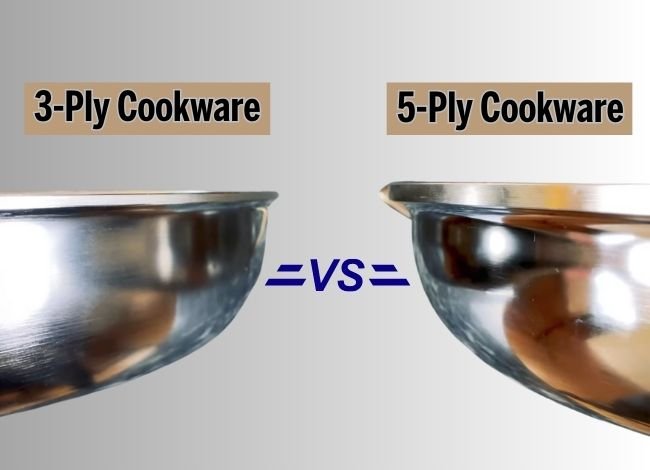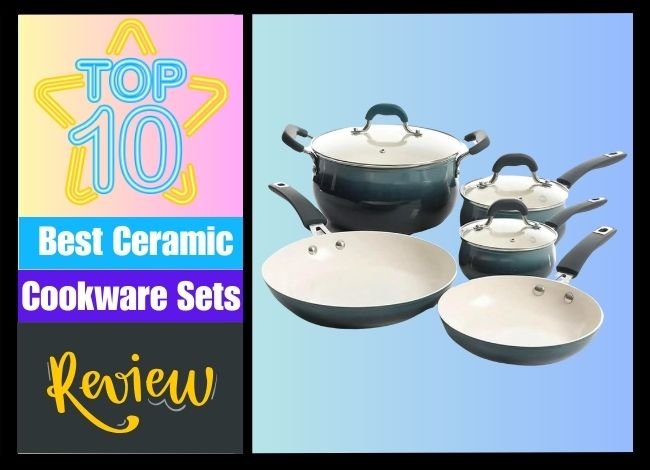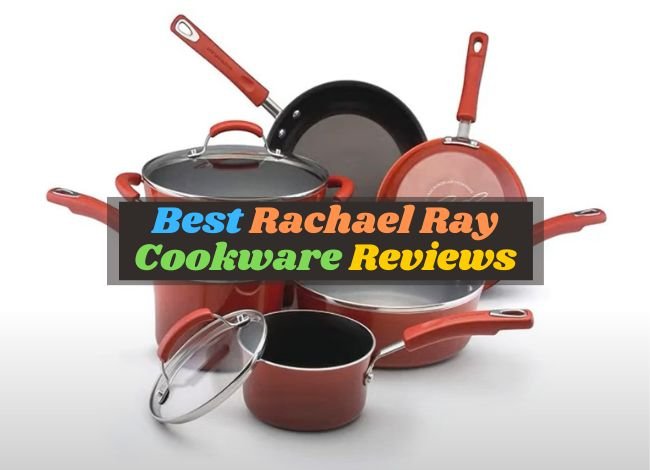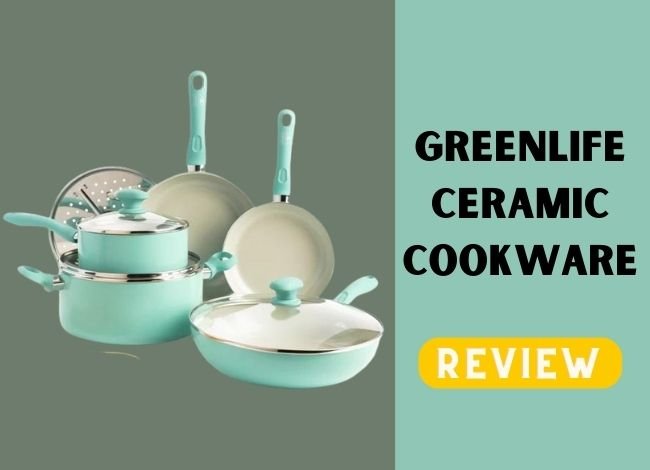Last Updated on January 18, 2024
When shopping for cookware, it’s essential to consider the construction of the pans and pots. Cookware is typically constructed with multiple layers of metal, known as ply or clad. This article will compare 3-ply and 5-ply cookware, highlighting their differences and benefits. We will begin with a comparison table and a more in-depth discussion.
| Feature | 3-Ply Cookware | 5-Ply Cookware |
|---|---|---|
| Layers of Material | 3 layers: stainless steel, aluminum, stainless steel | 5 layers: stainless steel, aluminum, aluminum alloy, aluminum, stainless steel |
| Heat Conductivity | Good | Excellent |
| Heat Distribution | Good | Very Good to Excellent |
| Heat Retention | Moderate | Good |
| Weight | Lighter | Heavier |
| Durability | Good | Better |
| Price | Moderate | More expensive |
| Reactivity | Low | Low |
| Induction Compatibility | Yes | Yes |
Construction:
3-ply cookware features a three-layer design that consists of an aluminum core sandwiched between two layers of stainless steel. The aluminum core provides good heat conductivity, while the stainless steel layers offer durability and a non-reactive cooking surface.
5-ply cookware, on the other hand, has a more complex construction with five layers of metal. This typically includes an aluminum core, an aluminum alloy layer, and three layers of stainless steel. The additional layers improve heat distribution, heat retention, and durability compared to 3-ply cookware.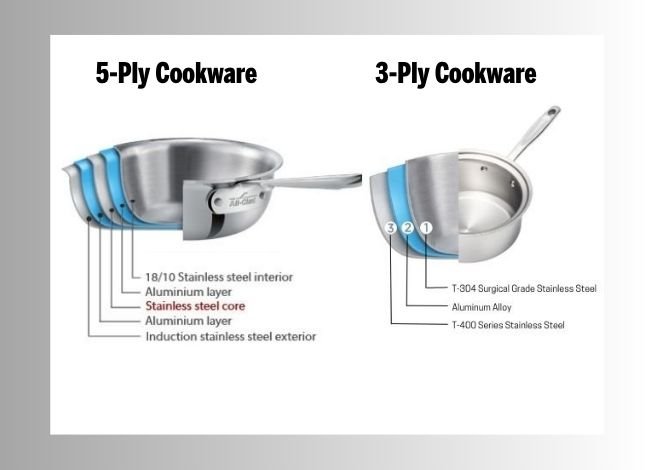
Heat Conductivity and Distribution:
3-ply cookware provides good heat conductivity and even heat distribution, thanks to its aluminum core. This ensures that food cooks evenly and reduces the risk of hot spots.
5-ply cookware offers even better heat distribution and conductivity due to its multiple layers of aluminum and aluminum alloy. The improved heat distribution results in more consistent cooking and makes 5-ply cookware suitable for a wider range of cooking techniques.
Heat Retention:
3-ply cookware has moderate heat retention, which means it may lose heat faster when food is added to the pan or when used in low heat settings.
5-ply cookware has better heat retention due to its thicker and more complex construction. This means it can maintain heat more effectively, ensuring consistent cooking results and making it suitable for tasks that require precise temperature control.
Weight:
3-ply cookware is generally lighter than 5-ply cookware due to its simpler construction. This can be advantageous when handling and moving pots and pans during cooking.
5-ply cookware is typically heavier because of its additional layers of metal. Some people may find this weight beneficial for better heat retention and stability on the stovetop, while others may prefer lighter cookware for ease of use.
Durability:
Both 3-ply and 5-ply cookware are durable and long-lasting, thanks to their stainless steel layers. However, 5-ply cookware has an edge in durability due to its thicker construction and additional metal layers.
Price:
3-ply cookware is generally more affordable than 5-ply cookware, making it a popular choice for those on a budget or looking for a balance between price and performance.
5-ply cookware is more expensive due to its more complex construction and better performance. However, for those who are willing to invest in high-quality cookware, the price difference may be justified by the improved cooking experience.
Reactivity:
When considering cookware, it’s essential to understand how the materials used in their construction react with different types of food. Reactivity refers to the tendency of a material to chemically react with the food being cooked, potentially altering the taste, color, and nutritional content.
In both 3-ply and 5-ply cookware, the outer and inner layers are usually made of non-reactive materials such as stainless steel, which doesn’t interact with acidic or alkaline foods. This non-reactive property makes stainless steel a popular choice for cookware construction. The middle layers in both 3-ply and 5-ply cookware typically consist of materials with excellent heat conductivity, such as aluminum or copper. These materials are sandwiched between the stainless steel layers, ensuring they do not come in direct contact with the food.
Since both 3-ply and 5-ply cookware feature non-reactive stainless steel surfaces, there is no significant difference in reactivity between the two types. You can expect consistent and unaffected taste, color, and nutritional content when cooking with either 3-ply or 5-ply cookware.
Related Article: All-Clad D3 vs. D5: Which Stainless Steel Cookware Is Better?
FAQs
Question: Which brand is more affordable, Calphalon or Cuisinart?
Answer: Generally, Cuisinart cookware is more affordable than Calphalon, but prices may vary depending on the specific product line and features.
Question: Are Calphalon and Cuisinart products non-stick?
Answer: Both brands offer non-stick cookware options, but they also have stainless steel and other types of cookware in their product lines.
Question: Are Calphalon and Cuisinart cookware dishwashers safe?
Answer: Most Calphalon and Cuisinart cookware is dishwasher safe, but it’s essential to check the specific product guidelines to ensure proper care.
Question: Is Calphalon or Cuisinart cookware better for even heat distribution?
Answer: Both brands are known for their excellent heat distribution, but Calphalon’s hard-anodized aluminum construction generally provides better heat distribution than some of Cuisinart’s lower-end stainless steel cookware.
Question: Are Calphalon and Cuisinart cookware oven-safe?
Answer: Yes, both brands offer oven-safe cookware options, but the maximum oven-safe temperature may vary depending on the specific product line.
Question: Which brand offers a better warranty, Calphalon or Cuisinart?
Answer: Both brands provide limited lifetime warranties for their cookware, but the terms and conditions may vary between products.
Question: Can I use metal utensils with Calphalon and Cuisinart non-stick cookware?
Answer: It’s generally recommended to use non-metal utensils with non-stick cookware to prevent scratching and damaging the non-stick coating.
Question: Is induction cooktop compatibility common in Calphalon and Cuisinart cookware?
Answer: Both brands offer induction-compatible cookware options, but not all product lines are suitable for induction cooktops. Always check the product specifications before purchasing.
Question: Which brand offers a more extensive range of cookware sets, Calphalon or Cuisinart?
Answer: Both brands offer a wide variety of cookware sets, but Cuisinart generally has a broader selection of products and styles.
Question: Are Calphalon and Cuisinart products PFOA-free?
Answer: Yes, both brands produce PFOA-free cookware, ensuring that their non-stick coatings are safe for cooking.
Question: Can I use Calphalon or Cuisinart cookware on a gas stove?
Answer: Yes, both brands’ cookware is suitable for use on gas stoves.
Question: Which brand offers more durable cookware, Calphalon or Cuisinart?
Answer: Both brands are known for their durability, but Calphalon’s hard-anodized aluminum construction typically provides more extended-lasting performance.
Question: Are Calphalon and Cuisinart cookware sets available with glass lids?
Answer: Both brands offer cookware sets with glass lids, allowing you to monitor your food without lifting the lid and releasing heat.
Question: Do Calphalon and Cuisinart produce bakeware as well?
Answer: Yes, both Calphalon and Cuisinart offer a range of bakeware products, including baking sheets, muffin tins, and more.
Question: Are Calphalon and Cuisinart products eco-friendly?
Answer: Both brands are committed to producing eco-friendly products, with Calphalon’s eco-friendly non-stick coatings and Cuisinart’s GreenGourmet line as examples.

